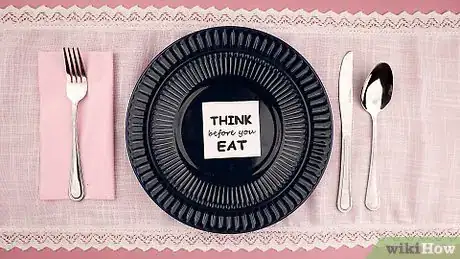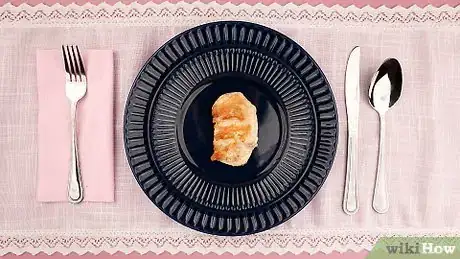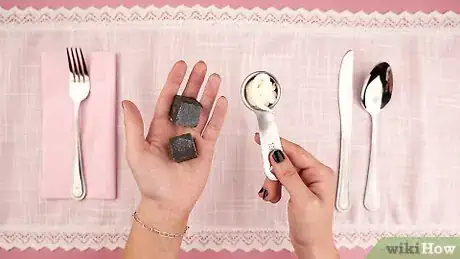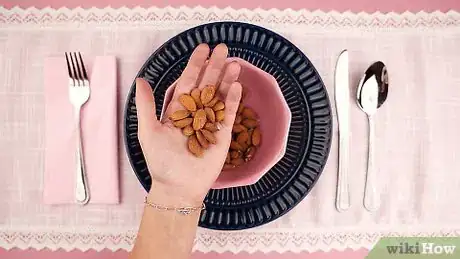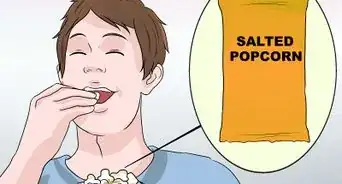This article was co-authored by Lyssandra Guerra and by wikiHow staff writer, Janice Tieperman. Lyssandra Guerra is a Certified Nutrition & Wellness Consultant and the Founder of Native Palms Nutrition based in Oakland, California. She has over five years of nutrition coaching experience and specializes in providing support to overcome digestive issues, food sensitivities, sugar cravings, and other related dilemmas. She received her holistic nutrition certification from the Bauman College: Holistic Nutrition and Culinary Arts in 2014.
There are 25 references cited in this article, which can be found at the bottom of the page.
wikiHow marks an article as reader-approved once it receives enough positive feedback. In this case, 92% of readers who voted found the article helpful, earning it our reader-approved status.
This article has been viewed 182,925 times.
When your stomach starts growling, it can be super tempting to pile your plate high with all your favorite foods. Unfortunately, really large portions can be a bit of a roadblock between you and your health and weight goals. Harvard Medical School even notes that larger meals can increase your risk factor for a variety of medical conditions.[1] Not to worry! Eating smaller portions, or portion control, is easy to master with a little bit of practice. We’ve put together some tips, tricks, and suggestions to help you get started.
Steps
Expert Q&A
-
QuestionHow do you portion a meal size?
 Lyssandra GuerraLyssandra Guerra is a Certified Nutrition & Wellness Consultant and the Founder of Native Palms Nutrition based in Oakland, California. She has over five years of nutrition coaching experience and specializes in providing support to overcome digestive issues, food sensitivities, sugar cravings, and other related dilemmas. She received her holistic nutrition certification from the Bauman College: Holistic Nutrition and Culinary Arts in 2014.
Lyssandra GuerraLyssandra Guerra is a Certified Nutrition & Wellness Consultant and the Founder of Native Palms Nutrition based in Oakland, California. She has over five years of nutrition coaching experience and specializes in providing support to overcome digestive issues, food sensitivities, sugar cravings, and other related dilemmas. She received her holistic nutrition certification from the Bauman College: Holistic Nutrition and Culinary Arts in 2014.
Certified Nutrition & Wellness Consultant Ideally, include some lean protein and a fruit or vegetable for a more complete meal. For example, you might have scrambled eggs with vegetables, whole grain oatmeal with fruit or greek yogurt with fruit.
Ideally, include some lean protein and a fruit or vegetable for a more complete meal. For example, you might have scrambled eggs with vegetables, whole grain oatmeal with fruit or greek yogurt with fruit. -
QuestionIs it better to eat small portions?
 Lyssandra GuerraLyssandra Guerra is a Certified Nutrition & Wellness Consultant and the Founder of Native Palms Nutrition based in Oakland, California. She has over five years of nutrition coaching experience and specializes in providing support to overcome digestive issues, food sensitivities, sugar cravings, and other related dilemmas. She received her holistic nutrition certification from the Bauman College: Holistic Nutrition and Culinary Arts in 2014.
Lyssandra GuerraLyssandra Guerra is a Certified Nutrition & Wellness Consultant and the Founder of Native Palms Nutrition based in Oakland, California. She has over five years of nutrition coaching experience and specializes in providing support to overcome digestive issues, food sensitivities, sugar cravings, and other related dilemmas. She received her holistic nutrition certification from the Bauman College: Holistic Nutrition and Culinary Arts in 2014.
Certified Nutrition & Wellness Consultant Yes. If you have a choice between two large meals and three smaller meals, the smaller meals are almost always going to be better for you. Always eat breakfast and then eat a small meal every 3-4 hours. Have a small, healthy snack in between meals if you start getting hungry. This makes it a lot easier for your body to maintain a consistent blood sugar and energy level throughout the day.
Yes. If you have a choice between two large meals and three smaller meals, the smaller meals are almost always going to be better for you. Always eat breakfast and then eat a small meal every 3-4 hours. Have a small, healthy snack in between meals if you start getting hungry. This makes it a lot easier for your body to maintain a consistent blood sugar and energy level throughout the day.
References
- ↑ https://www.health.harvard.edu/heart-health/eating-can-cause-low-blood-pressure
- ↑ https://pubmed.ncbi.nlm.nih.gov/18589036/
- ↑ https://www.bbc.com/news/health-11057891
- ↑ https://www.mayoclinic.org/healthy-lifestyle/nutrition-and-healthy-eating/in-depth/water/art-20044256
- ↑ https://pubmed.ncbi.nlm.nih.gov/15389416/
- ↑ https://www.ncbi.nlm.nih.gov/pmc/articles/PMC2128765/
- ↑ https://www.eatright.org/health/wellness/fad-diets/7-tips-for-healthy-dining-out
- ↑ https://www.halfyourplate.ca/fruits-and-veggies/what-is-a-serving/
- ↑ https://www.ncbi.nlm.nih.gov/pmc/articles/PMC2128765/
- ↑ https://sparq.stanford.edu/solutions/use-smaller-plates-smaller-waist
- ↑ https://www.heart.org/en/healthy-living/healthy-eating/eat-smart/nutrition-basics/portion-size-versus-serving-size
- ↑ https://www.cdc.gov/healthyweight/healthy_eating/portion_size.html
- ↑ https://www.bhf.org.uk/informationsupport/heart-matters-magazine/nutrition/weight/perfect-portions/top-tips-for-portion-control
- ↑ https://pubmed.ncbi.nlm.nih.gov/10743483/
- ↑ https://njaes.rutgers.edu/sshw/message/message.php?p=Health&m=150
- ↑ https://www.health.harvard.edu/staying-healthy/8-steps-to-mindful-eating
- ↑ https://www.heart.org/en/healthy-living/healthy-eating/eat-smart/nutrition-basics/suggested-servings-from-each-food-group
- ↑ https://www.mayoclinic.org/healthy-lifestyle/weight-loss/multimedia/portion-control/sls-20076148
- ↑ https://pubmed.ncbi.nlm.nih.gov/14995052/
- ↑ https://www.heart.org/en/healthy-living/healthy-eating/add-color/how-to-eat-more-fruits-and-vegetables
- ↑ https://pubmed.ncbi.nlm.nih.gov/18469287/
- ↑ https://www.heart.org/en/healthy-living/healthy-eating/eat-smart/nutrition-basics/suggested-servings-from-each-food-group
- ↑ https://www.mayoclinic.org/healthy-lifestyle/weight-loss/multimedia/portion-control/sls-20076148
- ↑ https://www.heart.org/en/healthy-living/healthy-eating/eat-smart/nutrition-basics/suggested-servings-from-each-food-group
- ↑ https://www.eatright.org/health/wellness/healthy-habits/5-tips-to-curb-your-late-night-snacking
- ↑ https://medlineplus.gov/ency/article/002093.htm
- ↑ https://www.mayoclinic.org/healthy-lifestyle/weight-loss/multimedia/portion-control/sls-20076148
- ↑ https://www.heart.org/en/healthy-living/healthy-eating/eat-smart/nutrition-basics/suggested-servings-from-each-food-group
- ↑ https://pubmed.ncbi.nlm.nih.gov/21335996/
- ↑ https://www.heart.org/en/healthy-living/healthy-eating/eat-smart/nutrition-basics/suggested-servings-from-each-food-group
- ↑ https://www.heart.org/en/healthy-living/healthy-eating/eat-smart/nutrition-basics/suggested-servings-from-each-food-group
- ↑ https://www.mayoclinic.org/healthy-lifestyle/nutrition-and-healthy-eating/in-depth/fiber/art-20043983?p=1
- ↑ https://www.mayoclinic.org/healthy-lifestyle/nutrition-and-healthy-eating/in-depth/fiber/art-20043983?p=1
- ↑ https://www.health.harvard.edu/blog/should-i-be-eating-more-fiber-2019022115927
About This Article
To eat smaller portions during meals, portion out your food on small-sized plates to reduce the amount of food you’ll eat. During meals you can set a timer for 20 minutes to help you eat more slowly, which will give your body time to become full, reducing the urge to overeat. A good way to space out your meal is to put down your fork between bites and to take sips of water. Finally, remember to stop eating when you’re satisfied, not full, as this will ensure you don’t overeat. To learn how to incorporate more fruits and vegetables into your meals, read more from our Dietician co-author.


